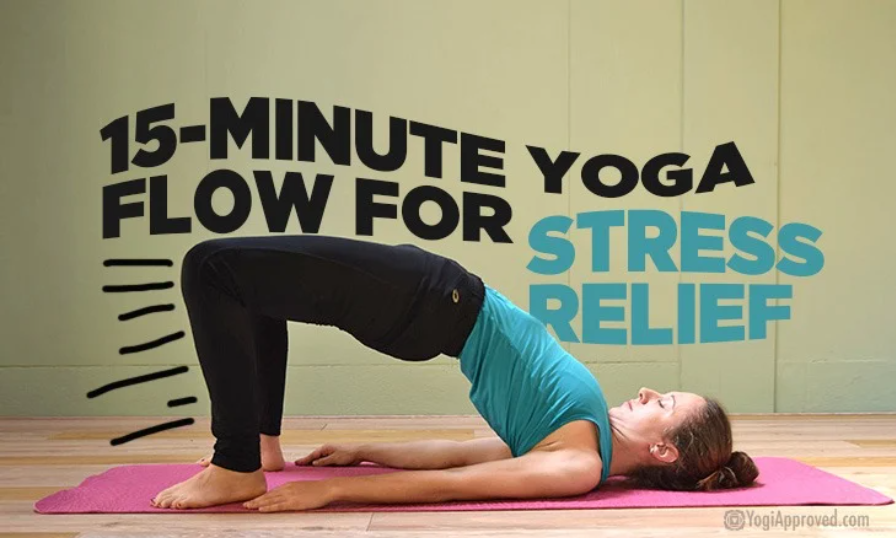Yoga is a powerful tool for managing anxiety. A gentle, mindful practice can help calm the nervous system, reduce stress, and promote relaxation. Below is a 15-minute yoga flow designed to relieve anxiety. This flow incorporates deep breathing, grounding postures, and gentle movement to help center the mind and calm the body.
1. Seated Meditation (2 minutes)
Purpose: Centering and calming the mind.
- Sit comfortably in a cross-legged position (Sukhasana) or any seated posture that feels good to you.
- Close your eyes, relax your shoulders, and rest your hands on your knees or in your lap.
- Take a few deep breaths in through your nose, allowing your belly to rise. Exhale slowly through your mouth, releasing tension.
- Focus on your breath: inhale for 4 counts, hold for 4 counts, exhale for 6 counts. This 4-4-6 breath can help slow your heart rate and calm the mind.
- If your mind wanders, gently bring your attention back to your breath.
2. Cat-Cow Pose (1 minute)
Purpose: Release tension in the spine and activate the parasympathetic nervous system.
- Start in a tabletop position on your hands and knees (shoulders over wrists, hips over knees).
- Inhale as you drop your belly toward the mat, lift your chest and tailbone toward the sky, and look slightly upward (Cow Pose).
- Exhale as you round your spine, tuck your chin, and push through your hands and knees (Cat Pose).
- Continue to flow between these two poses with your breath for 1 minute, moving slowly and mindfully.
3. Child’s Pose (2 minutes)
Purpose: Grounding and calming the nervous system.
- From tabletop, gently lower your hips back toward your heels and extend your arms forward, bringing your forehead to the mat (or use a prop like a block for your head if needed).
- Breathe deeply into your back, allowing the chest and ribcage to expand as you inhale and relax as you exhale.
- Hold for 1-2 minutes, focusing on grounding yourself and softening your body with each breath.
4. Downward-Facing Dog (1 minute)
Purpose: Release tension in the back and legs, and improve circulation.
- From Child’s Pose, come back to your tabletop position.
- Tuck your toes, lift your hips toward the ceiling, and straighten your legs to form an inverted V-shape (Downward-Facing Dog).
- Press your palms firmly into the mat and allow your heels to slowly move toward the ground.
- Hold for 5-8 breaths, gently pedaling your feet to stretch your calves and hamstrings.
- If your hamstrings are tight, bend your knees slightly.
5. Forward Fold (1 minute)
Purpose: Calm the mind and release tension in the back and legs.
- Walk your feet towards your hands, coming into a forward fold with your feet hip-width apart.
- Let your head hang heavy and your upper body relax toward your thighs.
- You can bend your knees slightly to keep the back of your legs relaxed, or if you feel comfortable, keep your legs straight.
- Gently sway side to side to release tension in the lower back, and then hold the fold for 5-8 deep breaths.
6. Standing Forward Fold to Mountain Pose (2 minutes)
Purpose: Improve circulation and return to an upright, centered position.
- Inhale as you roll up slowly from your forward fold, vertebra by vertebra, until you reach standing.
- Bring your arms up overhead and reach tall (Mountain Pose).
- Exhale and release your arms by your sides, feeling grounded through your feet.
- Stand tall, focusing on your breath. Inhale deeply through your nose and exhale through your mouth.
7. Warrior II (2 minutes)
Purpose: Build strength, focus, and stability, while releasing tension.
- From Mountain Pose, step your left foot back and bend your front knee to create a 90-degree angle in the front leg (Warrior II).
- Open your hips and shoulders toward the front of the mat, and extend your arms parallel to the floor, palms facing down.
- Gaze over your front fingers, grounding your feet into the earth.
- Hold for 5-8 breaths, focusing on your strength and stability.
- Switch sides, stepping the right foot back and repeating Warrior II on the other side.
8. Seated Forward Fold (1 minute)
Purpose: Release any lingering tension in the lower back and legs.
- After standing, sit on the floor with your legs extended straight out in front of you (Staff Pose).
- Inhale, lengthen your spine, and exhale as you fold forward, reaching for your feet, ankles, or shins (keeping your back long).
- Let your head and neck relax, and breathe deeply into your back.
- Hold for 1 minute, allowing the body to release tension with each breath.
9. Legs Up the Wall (2 minutes)
Purpose: Deep relaxation and grounding.
- Find a wall and lie on your back with your hips close to the wall and your legs extended up the wall.
- Let your arms rest by your sides or place them on your belly.
- Focus on your breath, letting go of any tension in the legs, hips, and lower back.
- Stay here for 1-2 minutes, allowing the blood to flow back toward your heart and relaxing the nervous system.
10. Savasana (1 minute)
Purpose: Deep relaxation and integration of the practice.
- Lie flat on your back with your legs extended and arms resting by your sides, palms facing up.
- Close your eyes, and allow your body to relax into the floor.
- Focus on your breath, letting your body feel heavy and grounded.
- Stay here for at least 1 minute, allowing your body and mind to absorb the benefits of the practice.
Closing:
Before you finish, take a deep breath in, bring your palms together at heart center, and bow your head in gratitude for the time you took for yourself. Take a moment to appreciate your body, your breath, and the space of calm you’ve cultivated.
Tips for Practicing Yoga for Anxiety:
- Take it slow: There’s no rush. If any posture feels uncomfortable, adjust it or skip it altogether.
- Focus on your breath: The breath is your anchor during anxiety. Inhale slowly and exhale deeply.
- Be kind to yourself: If your mind wanders or you feel restless, don’t judge yourself. Simply bring your attention back to your breath and the present moment.
This flow is meant to help you feel grounded, calm, and more present. With regular practice, yoga can be a valuable tool in managing anxiety, helping you to reconnect with your body and your breath, and find peace in the moment.


